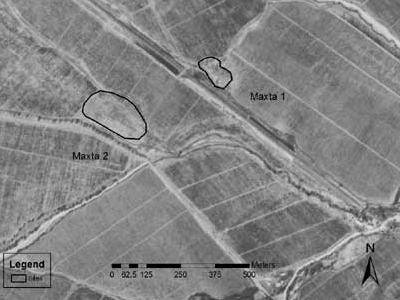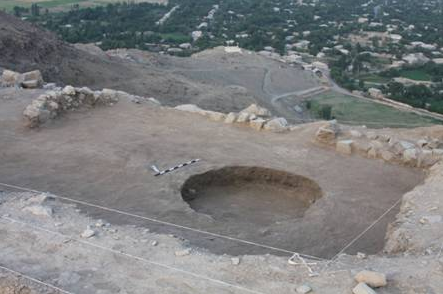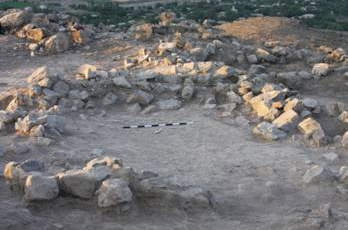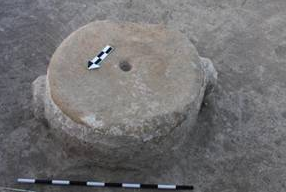In 2009, the Naxçıvan Archaeological Project returned to Oğlanqala, Azerbaijan for a second season of excavations and survey. During the 2009 season we began extensive excavation in two areas: the administrative building located at the citadel and a district of small private houses south and east of the citadel (Figure 1). Kathleen Nicoll and Bradley Parker (University of Utah) joined us for two weeks to resurvey the Iron Age and Early Bronze Age sites in Sharur Province which had been located in 2006. They also initiated a fieldwalking project in the fields immediately around Oğlanqala to investigate whether or not the fortress had a lower town. The 2009 excavations were extremely important since they gave us a clearer idea of the sequence of settlement at Oğlanqala. We now know that the palace was probably founded between 800 and 750 BCE (Period IIIa), and we have a clearer idea of who built this fortress. The second major occupation phase occurred in the fourth century, probably at the end of the Achaemenid empire, or just after Alexander the Great's conquests (Period IIIb). The third occupation phase, which consists of pits in the citadel palace, but more extensive architecture in the southern part of the site, dates to between 100 BCE and 100 CE (Period II). Finally, the most recent archaeological remains on the citadel come from foxholes, graves, and temporary shelters that date to the end of the first world war and the Soviet occupation of Naxçıvan (Period I).
Period IIIb: On the Borders of Urartu (800-600 BC)
During the early 8th century many Urartian fortresses were founded in the Ararat and Horom plains, but there is growing evidence that Oğlanqala was not an Urartian city. Architectural details, the layout of this complex and the distinctive pottery found here indicate that Oğlanqala was the capital of a small, local kingdom, probably centered on the Sharur Plains. It is possible that Oğlanqala belonged at some stage to the coalition of small states and tribes that the Urartians called Etiuni, against whom Urartu waged wars in the 9th and 8th centuries, although most of the states of Etiuni were located further north, near Lake Sevan. Two Urartian inscriptions have been found in Naxçıvan , one at Ilandağ, a mountain 75 km southeast of the site and another near a Medieval caravanserai called Fərhəd evi (Figure 2). The inscription at Fərhəd evi is sadly illegible, but in the Ilandağ inscription, the Urartian coregents Išpuini and Menua, record their victories in the region during a military campaign that took place between 820 and 810 BC. In their meter long inscription, Išpuini and Menua boast that they have conquered the lands of Arsinie and Ania, erected an inscription in Puluadu and instituted sacrifices in honor of the Urartian military god Haldi there. Despite their bombast, it seems that Urartu never annexed this area, as there is no epigraphic or archaeological evidence for Urartian fortresses here.
Oğlanqala was thus located on Urartu's border, and our excavations suggest that its early history is tied up with Urartu's (Figure 3). Ceramics and small objects found at Oğlanqala attest to connections between Oğlanqala and Urartu—as well as trade with other communities in Iran and Georgia. The pithos fragments inscribed with cuneiform signs that we have found at the palace show that Oğlanqala probably borrowed writing from Urartu as well. Our excavations of Period IIIa houses in Oğlanqala's southeast quadrant indicate that many of its inhabitants were probably herders, who may have only spent a few months each year at the site, taking advantage of winter pasture along the Araxes. These herders may well have traveled widely and brought back some of the exotic goods we have found in excavation. Other objects may have come to Oğlanqala as diplomatic gifts or part of various long-distance trading networks.
Period IIIa: The End of the Achaemenid Empire (400-300 BC)
More than four centuries after the citadel was built, the people of ancient Oğlanqala began work on a second palace, built directly atop the earlier ruins. As part of this project they placed columns in the 700m2 (7500 sq ft) central courtyard, made from two types of non-local stone. These had to be hauled up the mountain, probably in pre-worked blocks (Figure 4). Then masons carved bell-shaped column bases, column drums and even a column capital—as part of a project to set up large stone columns across this hall. But the project was never finished. Some column drums were only partly shaped from their original square slabs. Most others still had their lifting bosses attached. The column bases were not smoothed and fluting was never added (Figure 5).
The material from the late 4th century BC is enigmatic—it’s hard to date precisely or to determine which culture it belonged to. The C14 dates from this building level span the 4th century, with their midpoint between 340 and 320 BC, meaning that the site could be either late Achaemenid or Hellenistic. Given the columns and pottery, however, it seems more likely to be a late Achaemenid construction, one that was perhaps abandoned, unfinished, when the last Achaemenid king died, his empire lost to Alexander of Macedon.
Period II: Feasting in the Ruins (100 BC-100 CE)
After the palace at Oğlanqala was abandoned, there is little evidence of occupation in this area for at least two hundred years. Nearly 100 trash pits, burials or hearths have been dug into the ruins of the Period IIIb palace (Figure 6). Some of these may date to Period IIIa and were probably dug by labourers working on the palaces reconstruction. Many others, particularly several large pits full of animal bones, cooking and serving ware date to Period II (Figure 7). The Period II pits are not associated with any architecture or other living remains. Hannah Lau (UCLA) is analyzing the animal bones from these pits. Although her analysis is still in its early stage, it seems that the animal bones in the pits differ in terms of composition from those found elsewhere on the site. They could contain the remains of feasts-- the bones left from sides of beef and mutton, eaten in the ruins of the palace, or other special processing activities. A building discovered in 2008 (Achaemenid Houses) has now been redated to Period II, indicating more extensive occupation at Oğlanqala. Long after its abandonment, the impressive ruins of the citadel continued to be important. Perhaps the feasts in the old palace served to cement the authority of the Period II rulers.
Period I: World War I
More than 2000 years after these late Hellenistic picnics, Oğlanqala was reoccupied for a brief period, possibly just a few months to a year from the summer of 1919 to 1920. Warfare continued on the Caucasus front during WWI long after it had ended in Europe, devolving into a series of skirmishes fought by the fleetingly independent republics of the Southern Caucasus-- Armenia, Georgia and Azerbaijan—with the diplomatic and military involvement of Turkey, France, Britain, the US and the Soviet Union. In June 1919, the Azerbaijani speaking inhabitants of Naxçıvan revolted against Armenia, creating a very short-lived independent republic out of this exclave. One year later, Soviet tanks rolled into Naxcivan, intent on finishing their conquest of the Southern Caucasus. During the ensuing chaos, Naxçıvani villagers and resistance fighters fled to the hills. Some of them set up camp in the ruins of Oğlanqala’s palace, using ancient stones to build temporary shelters across the site (Figure 8). 18 modern graves from this period have been excavated, and are being analyzed by Amber Weekes for her MA thesis at Penn. At least seven children and one woman are among the dead. The other ten individuals are young men, at least one of whom may have served in the Imperial Russian army, judging by a button from his great coat (Figure 9).
The 2009 excavations have thus set the stage for further work in the region. Future excavations will further explore the relationship between Oğlanqala and its neighbors in terms of pastoral migration, frontier dynamics and the archaeology of resistance.




